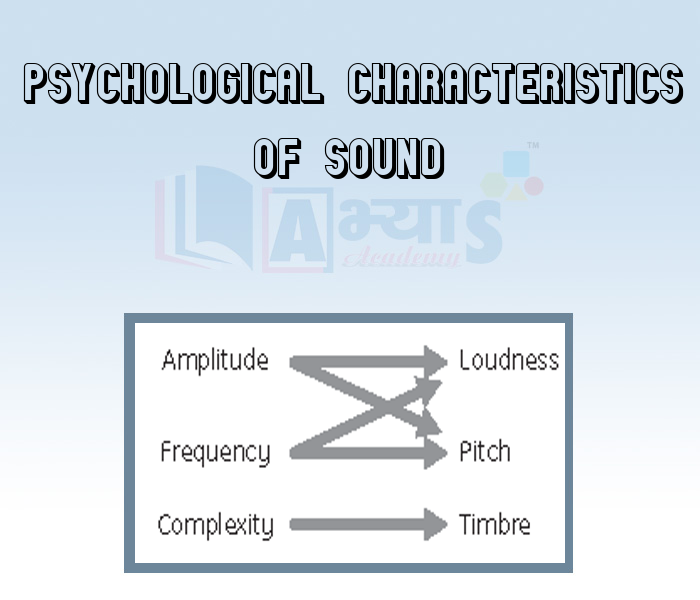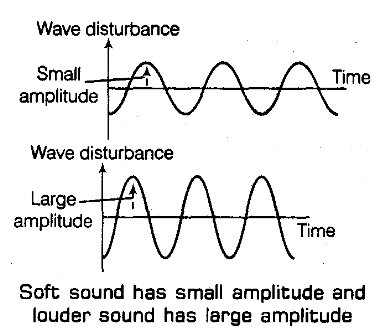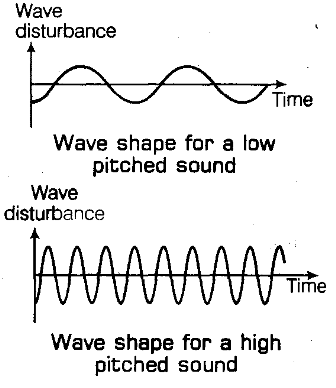Psychological Characteristics of Sound











Psychological Characteristics of Sound
Psychological Characteristics of sound: A sound has three characteristics such as loudness, pitch and quality (or timbre).
1. Loudness: It is the measure of the sound energy reaching the ear per second. Greater the sound energy reaching our ear per second, louder the sound will appear to be. If the sound waves have a small amplitude, then sound will be faint or soft but, if waves have a large amplitude, then the sound will be loud. Figure given shows the wave shapes of a loud and a soft sound of the same frequency.

Characteristics of loudness of sound:
1. Since, the amplitude of a sound wave is equal to the amplitude of vibrations of the source producing the sound waves, hence the loudness of sound depends on the amplitude of vibrations of the source producing the sound waves.
2. Loud sound can travel a larger distance as it is associated with higher energy.
3. A sound wave spreads out from its source, as it moves away from the source, its amplitude as well as its loudness decreases. The loudness of sound is measured in decibel (dB). It depends on the sensitivity or the response of our ears.
2. Intensity: The amount of sound energy passing each second through unit area is known as the intensity of sound. Loudness and intensity are not the same terms. Loudness is a measure of the response of the ear to the sound. Even when two sounds are of equal intensity, we may hear one as louder than the other, simply because our ear detects it in better way. The SI unit of intensity is watt per square metre ()
2. Pitch or Shrillness: It is that characteristic of sound by which we can distinguish between different sounds of the same loudness. Due to this characteristic, we can distinguish between a man’s voice and woman’s voice of the same loudness without seeing them. Pitch of a sound depends on the frequency of vibration. Greater the frequency of a sound, the higher will be its pitch. In other words, the faster the vibration of the source, the higher is the frequency and hence higher is the pitch, as shown in figure. Thus, a high pitch sound corresponds to more number of compressions and rarefactions passing through a fixed point per unit time. Low pitch sound has low frequency and high pitch sound has high frequency.

3. Quality or Timbre: The quality or timbre of sound is that characteristic of sound which enables us to distinguish one sound from another having the same pitch and loudness. The pleasant sound is said to be of a rich quality. A sound of single frequency is called a tone. The sound produced due to a mixture of several frequencies is called a note and is pleasant in listening too. Noise is unpleasant to ear, music is pleasant to ear and is of rich quality.
The energy carried by the sound wave can be inferred from | |||
| Right Option : D | |||
| View Explanation | |||
The periodic vibrations of sound produces ___________________ . | |||
| Right Option : A | |||
| View Explanation | |||
A shrill sound has a ____ pitch and dull sound has a ____ pitch. | |||
| Right Option : A | |||
| View Explanation | |||
Students / Parents Reviews [20]
Being a parent, I saw my daughter improvement in her studies by seeing a good result in all day to day compititive exam TMO, NSO, IEO etc and as well as studies. I have got a fruitful result from my daughter.

Prisha Gupta
8thI have spent a wonderful time in Abhyas academy. It has made my reasoning more apt, English more stronger and Maths an interesting subject for me. It has given me a habbit of self studying

Yatharthi Sharma
10thAbhyas institute is one of the best coaching institute in the vicinity of Ambala Cantt area. The teachers of the institute are well experienced and very helpful in solving the problems of the students.The good thing of the institute is that it is providing extra classes for the students who are w...

Aman Kumar Shrivastava
10thMy experience was very good with Abhyas academy. I am studying here from 6th class and I am satisfied by its results in my life. I improved a lot here ahead of school syllabus.

Ayan Ghosh
8thOne of the best institutes to develope a child interest in studies.Provides SST and English knowledge also unlike other institutes. Teachers are co operative and friendly online tests andPPT develope practical knowledge also.

Aman Kumar Shrivastava
10thAbhyas academy is great place to learn. I have learnt a lot here they have finished my fear of not answering.It has created a habit of self studying in me.The teachers here are very supportive and helpful. Earlier my maths and science was good but now it has been much better than before.

Barkha Arora
10thAbhyas is an institute of high repute. Yogansh has taken admission last year. It creates abilities in child to prepare for competitive exams. Students are motivated by living prizes on basis of performance in Abhyas exams. He is satisfied with institute.

Yogansh Nyasi
7thAbhyas Methodology is very good. It is based on according to student and each child manages accordingly to its properly. Methodology has improved the abilities of students to shine them in future.

Manish Kumar
10thMy experience with Abhyas is very good. I have learnt many things here like vedic maths and reasoning also. Teachers here first take our doubts and then there are assignments to verify our weak points.

Shivam Rana
7thWe started with lot of hope that Abhyas will help in better understnding of complex topics of highers classes. we are not disappointed with the progress our child has made after attending Abhyas. Though need to mention that we expected a lot more. On a scale of 1-10, we would give may be 7.

Manya
8thAbhyas is good institution and a innovative institute also. It is a good platform of beginners.Due to Abhyas,he has got knoweledge about reasoning and confidence.My son has improved his vocabulary because of Abhyas.Teacher have very friendly atmosphere also.

Manish Kumar
10thMy experience with Abhyas Academy has been very good. When I was not in Abhyas whenever teacher ask questions I could not speak it confidently but when I came in Abhyas, my speaking skills developed and now I am the first one to give the answer of teachers question.

Upmanyu Sharma
7thThird consective year,my ward is in Abhyas with nice experience of admin and transport support.Educational standard of the institute recumbent at satisfactory level. One thing would live to bring in notice that last year study books was distributed after half of the session was over,though study ...

Ayan Ghosh
8thAbhyas institute is one of the best coaching institute in the vicinity of Ambala cantt.The institute provides good and quality education to the students.The teachers are well experienced and are very helpful in solving the problems. The major advantages of the institute is extra classes for weak...

Shreya Shrivastava
8thIt was a good experience with Abhyas Academy. I even faced problems in starting but slowly and steadily overcomed. Especially reasoning classes helped me a lot.

Cheshta
10thA marvelous experience with Abhyas. I am glad to share that my ward has achieved more than enough at the Ambala ABHYAS centre. Years have passed on and more and more he has gained. May the centre flourish and develop day by day by the grace of God.

Archit Segal
7thIt has a great methodology. Students here can get analysis to their test quickly.We can learn easily through PPTs and the testing methods are good. We know that where we have to practice

Barkha Arora
10thWhen I have not joined Abhyas Academy, my skills of solving maths problems were not clear. But, after joining it, my skills have been developed and my concepts of science and SST are very well. I also came to know about other subjects such as vedic maths and reasoning.

Sharandeep Singh
7thIt was good as the experience because as we had come here we had been improved in a such envirnment created here.Extra is taught which is beneficial for future.

Eshan Arora
8thMy experience with Abhyas academy is very good. I did not think that my every subject coming here will be so strong. The main thing is that the online tests had made me learn here more things.
